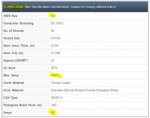re-evaluating
Member
- Location
- Illinois
Specifically I am working on a UL Listed stainless steel Chef's counters (with load center). I am required to use SRML 150*c wire per UL (SRML I am using is tin coated copper) to supply power to inductive food warmers. During testing we see temperatures in the 75*c range as a constant operating temperature of shelf that houses the wireway. Wireways typically 8" to 12" wide by 2" to 2 1/2" deep, and can house 6 to 30 conductors. I realize the temperature above isn't exactly the temp of the air in the raceway but if I assume the worst it should give some safety margin I would think (please correct if I am wrong). I have looked all over 310 but don't see any thing that really helps me determine what ampacity my 12 gauge (or 10 gauge) SRML is at my ambient temperature. I want to make sure I am quoting and supplying the proper size for safety sake. I have been searching and reading all kinds of information but still don't have a confidence level to know I am bidding these correctly. Thank you all for your time.
Dave
Dave




